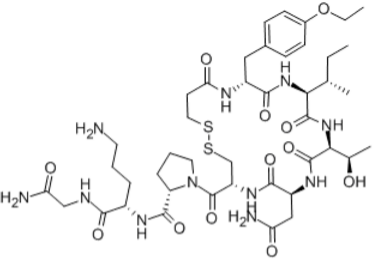2024-07-09
Introduction
This article will give a brief introduction about atosiban and focus on its role played in the treatment of preterm labor. Atosiban is an oxytocin-receptor antagonists, and it was marketed in China in 2006. The general structure of atosiban is shown in Fig.1. Spontaneous preterm labor is a major cause of neonatal morbidity and death worldwide. Pharmacologic inhibition of uterine contractility (tocolysis) to postpone delivery is the current mainstay of preterm labor management. Although sympathomimetic agents such as ritodrine are able to delay delivery for up to 48 hours in patients with an acute episode of preterm labor, these patients remain at risk of having recurrent episodes of preterm labor, need for hospitalization, retreatment with intravenous tocolytic agents, and preterm birth. Fortunately, Atosiban could provide a maintenance therapy to prevent these complications.

Fig. 1 The general structure of atosiban
Mechanism
Atosiban can competitively bind to oxytocin receptors in the decidual membrane and the myometrium of the uterus, inhibiting the increase of oxytocin receptors so as to lower the number of the receptors, This could, in a way, reduce the effect of oxytocin.
Efficacy evaluation
Shim et al. proposed that atosiban was significantly better than litojun in effect and safety, compared with atosiban and β2 receptor agonists, respectively 59.7 % and 47.4 % in inhibiting uterine contractions. A multicenter and double-blind study carried out by Romero, which used placebo as controlled trial (atosiban group contained 246 cases, and control group contained 255 cases), demonstrated that the rates of delivery after 48 hours (67% : 56%) and after 7 days (62% : 49%) in the atosiban group were significantly higher than those in the control group. Another randomized, controlled, double-blind multicenter trial (a total of 733 cases of pregnant women from three countries) conducted by Coomarasamy showed that the atosiban group compared with the β2 agonists group, has no statistically significant difference in births within 48 hours ( 88.1% : 88.9% ), 7 days births (79.7% : 77.6% ), delivery gestational age (35.8 weeks : 35.5 weeks) and the average neonatal birth weight (2491g : 2461g ). However, the untoward effect caused by the atosiban group was significantly weaker, especially that of angiocarpy (8.3% : 81.2%). There was also a significant reduction in the number of people who had to discontinue drugs on account of untoward effect (1.1% : 15.4%). But, Papatsonis et al. said such atosiban group compared with the placebo group did not reduce the incidence of birth before 37 weeks of gestational age, also before 28 weeks and before 32 weeks, as well as perinatal mortality and neonatal morbidity.
Clinical safety
1920 pregnant women from a total of 28 hospitals in the Netherlands or Belgium participated in a study conducted by De et al., and this study shows that atosiban has good maternal and fetal safety (only one of the 575 pregnant women had adverse reactions like nausea, with an incidence of 0.2 percent).
References:
Shim, J. Y., Park, Y. W., Yoon, B. H., Cho, Y. K., Yang, J. H., Lee, Y. and Kim, A. (2006). 'Multicentre, parallel group, randomised, single-blind study of the safety and efficacy of atosiban versus ritodrine in the treatment of acute preterm labour in Korean women’, Bjog An International Journal of Obstetrics & Gynaecology, 113( 11), 1228-1234.
Romero, R., Sibai, B. M., Sanchez, R. L., Valenzuela, G. J., Veille, J. C.,Tabor, B., and Perry, K. G. (2000). 'An oxytocin receptor antagonist (atosiban) in the treatment of preterm labor: a randomized, double-blind, placebo-controlled trial with tocolytic rescue’, American Journal of Obstetrics & Gynecology, 182(5), 1173-1183.
Coomarasamy, A., Knox E. M., Gee, H., and Khan, K. S. (2002). 'Oxytocin antagonists for tocolysis in preterm labour-a systematic review’, Med Sci Monit, 8(11), 268-273.
Papatsonis, D., Flenady, V., Liley, H. (2009), 'Maintenance therapy with oxytocin antagonists for inhibiting preterm birth after threatened preterm labour’, Cochrane Database Syst Rev, (1), CD005938.
De, H. R., Mol, B.W., Erwich, J. J., Geijnet, H. P., and Gyselaers, W. J. (2009), 'Adverse drug reactions to tocolytic treatment for preterm labour: prospective cohort study’, BMJ, 5(3), 738-744.